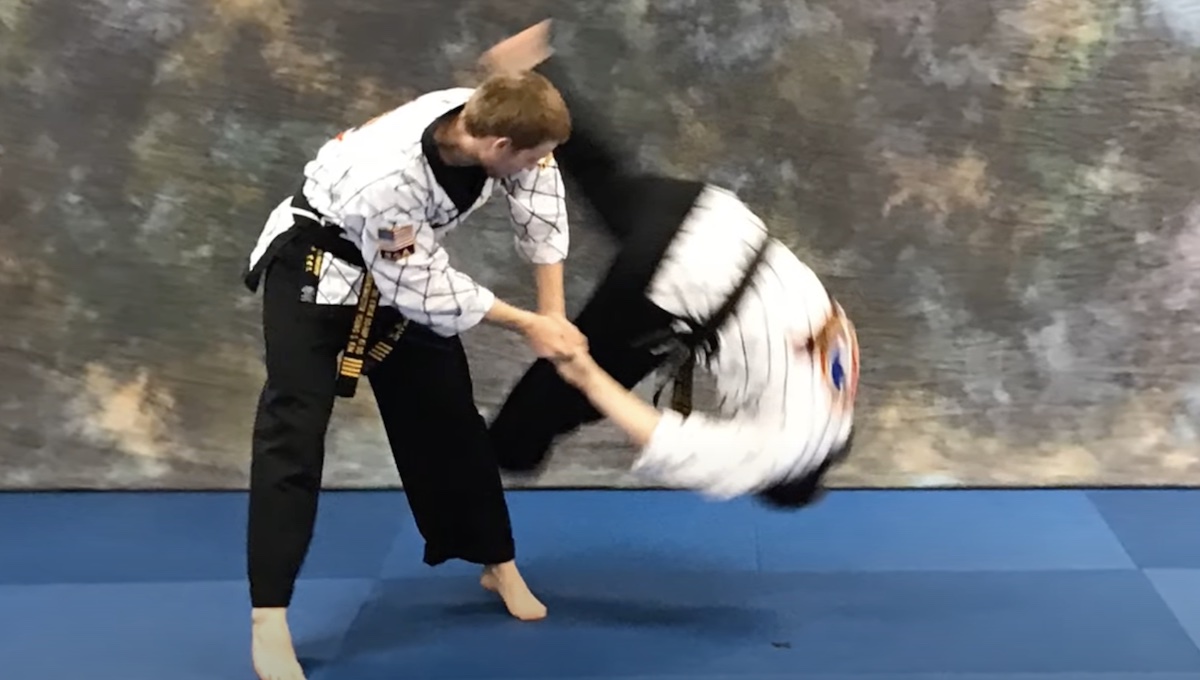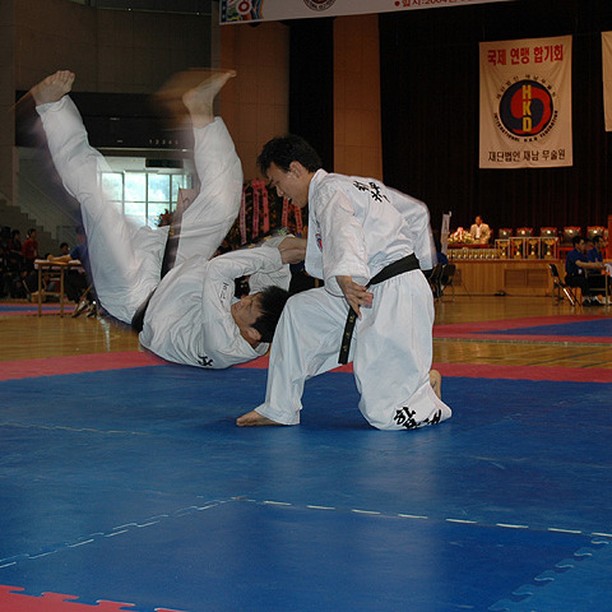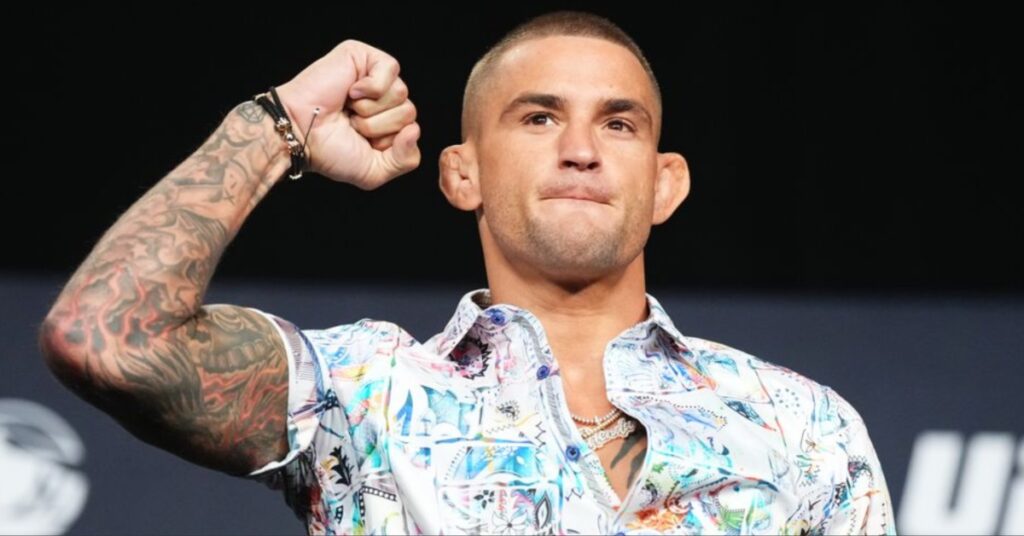Hapkido – The Hybrid Korean Martial Art

One martial art that you may have heard of, but know next to nothing about is Hapkido. The Korean martial art that has a wide variety of practical techniques.
Here is what you need to know about the Korean martial art known as Hapkido. Going over how it was developed, its techniques, and real world application.
The History of Hapkido
Hapkido is a Korean martial art that was developed during the mid twentieth-century. It was led by a group of martial artists that was led by Choi Yong-Sool.
Sool along with his team began creating their martial art after WW2, when Japan lost control of the country. Grandmaster Choi was influenced by various styles of martial arts, which included various traditional Korean martial arts.

How Choi Yong-Sool Became a Martial Artist
During the occupation of Korea by Japan, Choi was captured and taken to Japan. While stuck in the country, Choi would become a student of Daito-ryu Aiki-jujutsu teacher Sokaku Takeda.
He trained under Takeda for thirty years and mastered this art of jujutsu. Once WW2 ended, Choi would return to Korea.
Choi Begins Developing Hapkido
Once Choi returned to his homeland, he would begin teaching his form of jujutsu. But he would then get together with another group of Korean martial artists.
This group would begin practicing and sharing ideas with one another to create a new Korean martial art. That is how the art of Hapkido was formed.
The term “Hapkido” can be translated as “the way of coordinated power” or “way of harmony with the spirit.” This new martial art would have a base in grappling along with joint locks and striking.
Much like in the grappling art of Aikido, Hapkido’s movements would be focused on using an opponent’s energy against them. Redirecting their energy to mobilize them on the ground.
Hapkido Spreads Globally
The art of Hapkido would grow rather quickly in a short time period. Not spreading as fast as Taekwondo, but at quite a respectable pace.
Today, Hapkido is practiced globally and used within the training of Korean special forces.\

The Techniques of Hapkido
Hapkido is a diverse martial art that includes a wide range of different techniques. Everything from strikes, throws, joint locks, grappling, and pressure point holds.
- Hand Strikes: The hand strikes in Hapkido include punches, palm strikes, and ridge hands. Forearms and elbow strikes are also included in the curriculum.
- Kicks: A wide variety of roundhouses, front kicks, sidekicks, spinning kicks, and knee strikes are taught within Hapkido.
- Throws: Similar to Judo, Hapkido uses an attacking opponent’s momentum against them to set up various throws.
- Grappling: While not as in depth as BJJ or Judo, the martial art does include self-defense techniques on the ground. The main techniques consist of controls and escapes.
- Pressure Points: Along with grappling, there’s an emphasis on pressure point holds to control and immobilize an opponent.
Notable Hapkido Practitioners
There have been a wide variety of notable and respectable Hapkido practitioners in the martial art’s history. Here are some of the more notable practitioners.
Ji Han-jae
Master Ji Han-jae is one of the highest ranked Hapkido masters in the world. He has been teaching the Korean martial art for the last sixty years. Han-jae is also one of the key figures responsible for Hapkido spreading internationally.
Myung Jae-nam
Master Myung Jae-Nam was one of Grandmaster Choi’s most prominent students. After learning Hapkido, Jae-Nam went on to develop his own martial arts in Hankido and Hankmudo. Both of which were heavily influenced by Hapkido.
Han Bong-Soo
Master Han Bong-Soo was a Hapkido master that was heavily influential in bringing the martial art to the United States. He was also the founder of the International Hapkido Federation.
Geoff J. Booth
Geoff J. Booth is a Hapkido master and has been practicing the art for decades. He traveled to Korea to train extensively under Grandmaster Choi and his top students. Booth is one of the most respected Hapkido instructors from the west.
Scott Shaw
Another Hapkido master from the west that has spent decades learning and teaching it along with other martial arts. He is also a writer that has written extensively on this martial art, as well as self-defense theories.
Hapkido vs. Aikido
Hapkido is constantly compared to the art of Aikido. Let’s compare some of the similarities and glaring differences.
Similarities
Both martial arts were heavily influenced by forms of Japanese jujutsu with a base in grappling. The other similarity is that both styles use the principle of using their opponent’s energy against them. These are the two main similarities between the two styles.
Differences
While the two styles may seem similar, they also have some glaring differences. The biggest of which is that Hapkido includes various forms of striking within its teachings.
Aikido on the other hand is strictly a form of grappling that relies on throws and small join manipulations.
Also if we’re being honest, the art of Hapkido is proven far more effective than Aikido. The Korean martial art has more real world application and will do you better in self-defense situations.
Hapkido vs. Other Martial Arts
Hapkido has similar techniques to other widely practiced martial arts like Taekwondo, Karate, Muay Thai, and Taekwondo. Although, these other martial arts do these similar techniques far better than Hapkido.
A Muay Thai roundhouse is more powerful and the throws in Hapkido are more technically sound in Judo.
Although this is not to say Hapkido is a bad martial art. It has some good aspects within the system, but the other martial arts mentioned have been proven more effective.
Is Hapkido Effective?
While many martial arts critics have issues with Hapkido such as real world application, it’s not a bad martial art. There are many good techniques within the martial art that are good and will help you in a self-defense situation.
You shouldn’t rely on Hapkido alone for self-defense, but it does have aspects that are respectable. It wouldn’t be a total waste of your time to learn some techniques from this martial art.






